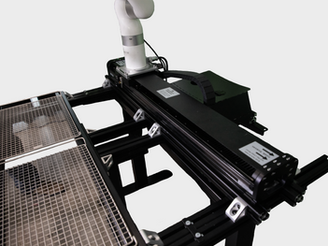top of page
Latest
Search

AI
Discover how artificial intelligence is reshaping automation, robotics, and manufacturing. Explore AI-powered solutions, machine learning, computer vision, and intelligent decision-making tools that drive smarter, faster, and more adaptive industrial systems.


Warehouse Picking Robots: Are They Worth the Investment?
Are warehouse picking robots worth it? This blog breaks down the pros and cons of investing in autonomous or semi-autonomous pickers. We explore deployment costs, integration with WMS, compatibility with varied SKUs, and labor offsets. With case studies and ROI timelines, you’ll get the data needed to evaluate whether robotic picking fits your facility and how fast you can recoup your investment.
2 min read


Automated Logistics Systems: Where to Start
For logistics managers looking to automate, it’s crucial to start with a roadmap. This blog outlines a beginner’s approach to logistics automation, from assessing bottlenecks to choosing technology partners and piloting new systems. Learn how to evaluate workflows like receiving, picking, packing, and shipping, then align automation tools with clear KPIs. The post also offers tips on vendor selection, staff training, and scaling after a successful pilot phase.
2 min read


How Robotics in Logistics Improves Accuracy and Speed
As logistics grows more complex, businesses turn to robotics to solve speed and accuracy challenges. This blog details how autonomous robots and cobots reduce human error, standardize processes, and improve throughput across the supply chain. From vision-assisted picking to AI-driven routing, robotics streamlines operations with consistent performance. Readers will also learn how robotic systems integrate with existing WMS and reduce fulfillment lag for growing ecommerce and
5 min read


Top Warehouse Automation Robots and Their Real-World Applications
Today’s warehouse robots do more than just lift and move. This post breaks down the top categories of warehouse robots—like AMRs, palletizers, and pick-and-place bots—and how they are used in modern logistics. You’ll also find real-world examples from ecommerce, B2B, and industrial sectors. Learn how to pair your needs with robot type, what ROI to expect, and what capabilities matter most when evaluating robotic tools for high-mix, high-speed operations.
3 min read


Why Now Is the Right Time to Automate Your Warehouse
Automation in warehousing is more accessible and affordable than ever before. This blog explores the market forces—like rising labor costs and fulfillment demand—that are driving companies to automate in 2025. We’ll highlight trends in modular robotics, subscription models for automation tools, and cobot deployment strategies. You’ll learn why now is the optimal time to invest in automation, with insights into cost recovery timelines, labor reallocation, and competitive advan
2 min read


From Manual to Cobot: How Small Warehouses Are Making the Leap
Smaller warehouses often face staffing shortages, tight budgets, and increasing order volumes. Collaborative robots—or cobots—offer a scalable and affordable automation solution. This blog highlights how even modest operations are using cobots to streamline processes like picking, kitting, and packing. With lower upfront costs, intuitive programming, and safety features that enable human-robot collaboration, cobots make it easy for small teams to scale output without sacrific
2 min read


Energy‑Efficient Spray Robots: Reducing Paint Waste & Cycle Time
Emerging research and industrial innovations show that subtle changes in robot motion—not just hardware upgrades—can save 20–30% in energy and cycle time without degrading finish quality for robot spray painting.
3 min read


Automating Paint Shops: How Paint Robots Improve Finish and Safety
Paint robots are changing the game in industrial finishing. This post dives into how robotic spray systems enhance quality, reduce overspray, and eliminate worker exposure to fumes. We’ll cover key components such as articulated arms, flow regulators, and programmable paths, and how they integrate with safety enclosures or cobot systems for flexibility. Learn how paint robots are used in automotive, furniture, and equipment manufacturing, and what ROI to expect from investing
2 min read


Adhesive Spray Options for Industrial Robot Applications
Adhesive spray for industrial robots plays a critical role in modern automation, enabling precise, durable, and efficient bonding across manufacturing processes. This article explores the main adhesive types—cyanoacrylate, epoxy, acrylic, and polyurethane—highlighting their benefits, selection criteria, and performance in robotic assembly, packaging, welding, and more. Learn how the right adhesive spray improves cycle times, reduces downtime, and boosts product quality in hig
8 min read


Direct Drive Linear Motor Applications in Precision Robotics: Key Uses and Benefits
Direct drive linear motor applications are redefining the standards of precision robotics by delivering high-speed, backlash-free motion with exceptional accuracy. This article explores how industries like semiconductor manufacturing, medical devices, and advanced automation benefit from these motors’ superior performance, reduced maintenance needs, and real-time responsiveness.
8 min read


Advanced Robotics Enhancing Food Safety Automation
Advanced robotics for food safety is revolutionizing the way the food industry manages contamination risks, quality control, and compliance. By integrating AI, machine vision, and automated inspection systems, companies are enhancing hygiene standards, reducing human error, and improving operational efficiency across every stage of food processing. This article explores the key technologies, benefits, and best practices driving this transformation.
7 min read


Direct Drive Linear vs Traditional Motors: Which Is Better for Your Application?
When comparing Direct Drive Linear vs Traditional motors, the choice comes down to precision, speed, maintenance, and lifecycle costs. This guide breaks down how each motor type performs in real-world automation settings—helping engineers and decision-makers choose the right solution for their application.
6 min read


Direct Drive Linear Motor Cost Explained: How Smart Investment Boosts Efficiency and Cuts Long-Term Expenses
Understanding direct drive linear motor cost is essential for manufacturers seeking to boost efficiency without sacrificing precision. This guide explores the real-world pricing factors, long-term savings, and ROI potential of direct drive systems. From initial investment to energy savings and reduced maintenance, it offers a clear breakdown to help you make informed, cost-effective decisions for your automation strategy.
8 min read


Fairino Robot Arm Pricing: Features, Models, and Cost Breakdown
Looking to invest in industrial automation? This pricing guide breaks down Fairino Robot Arm models, features, and total cost of ownership—helping you choose the right robotic solution for your operation. From injection molding to research labs, discover how Fairino delivers ROI, reliability, and next-gen precision.
10 min read


Fairino Robot Applications in Small Business Automation: How to Choose, Implement, and Maximize ROI
Fairino Robot Applications are revolutionizing small business automation by enhancing efficiency, reducing costs, and improving product quality. From precision assembly to real-time inspection, this guide explores how to choose the right model, implement it effectively, and maximize ROI through smart integration and streamlined workflows.
4 min read


What Are the Key Labor Challenges Addressed by Autonomous Robots?
Autonomous robots tackle major labor challenges including shortages, high costs, unsafe conditions, and inefficient repetitive tasks. Many industries – from manufacturing to logistics – face understaffing due to demographic shifts and skill gaps. Robots, with contributions from blue sky robotics, help maintain continuous operations by compensating for human shortages, enhancing capacity and efficiency even when labor is limited.
10 min read


How Autonomous Mobile Robots Are Reshaping Fulfillment: Key Benefits and Industry Impact
Autonomous Mobile Robots (AMRs) are revolutionizing fulfillment by streamlining warehouse operations, reducing labor costs, and boosting efficiency. This article explores how AMRs work, their key benefits, and the role leading autonomous mobile robot companies play in transforming logistics. With insights from real-world applications and integration strategies, it offers valuable guidance for businesses navigating digital transformation in supply chain management.
7 min read


GPT-5 Ushers in a New Era for AI: What Businesses Should Know
The future of artificial intelligence is here, and it’s faster, smarter, and more integrated than ever. With OpenAI’s recent roadmap...
2 min read


GPT-5 Roadmap Revealed: What It Means for AI Users and Developers
OpenAI has once again made headlines in the artificial intelligence community. During a recent roadmap reveal, CEO Sam Altman shed light...
2 min read


Smarter, More Human: What ChatGPT Update GPT-4.5 Means for Your Business
OpenAI’s latest model, ChatGPT 4.5, is here, and while it may not boast exponential leaps in raw reasoning power, it represents a major shift in how we interact with artificial intelligence. The emphasis? More human, intuitive, and emotionally intelligent conversations.
2 min read
bottom of page






